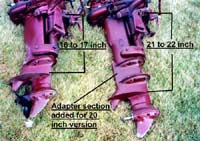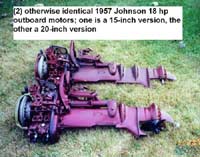I often hear asked how one can tell the difference
between a "long shaft" and a "short shaft" outboard. Another
frequent question is how one determines if an existing boat
is set-up for a long shaft or short shaft engine. And finally,
should a home-built boat be built to accept a long shaft or short
shaft engine?.
 click images to enlarge
click images to enlarge |
First, a little history; through some form of evolution, it evolved in the
early days of outboard motors that they would , generally, be designed
to be mounted on a boat transom measuring 15 inches in height.
At a later point in time, when it become apparent that increased
freeboard might be desirable on larger boats, a second "standard"
of a 20-inch-high transom was established. The 15 inch engines
were referred to as "standard" or "short" shaft engines, while the
20 inch engines were referred to as "long" shaft engines.
Through most of the 50's and 60's, nearly all outboards (there were
exceptions) where available in either version, although as the
engines become larger and larger, exceeding 100 hp in the early
60's, and exceeding 150 hp in the mid 70's, most of the bigger
engines were only available in the 20 inch "long" shaft version.
In the late 80's, with the increased popularity of deep-V offshore
boats, outboards designed for 25 inch transoms began to be
available, although these are almost always engines in excess of
100 hp. Only the smallest of engines, say under 40 hp, are still
available in the 15 inch "short" shaft version.
Because of confusion caused by the introduction of
the 25 inch engines, which are sometimes referred to as "long"
shaft engines, leaving the 20 inchers to be called "short' shafts,
I suggest we dispense with all the "short" and "long" nomenclature,
and instead refer to the particular engines by the "inch" measurements,
and since I only discuss "old"engines, that will limit us to 15 inch
and 20 inch engines.

First of all, how to identifying a 15 inch engine from a 20 inch engine; This
is fairly easy with OMC (Johnson, Evinrude, and Gale) engines, as
the 20 inch versions from the 50's and 60's, of no more than 40 hp,
always had an adapter piece added to the "leg" of the engine.
Shown here are photos of two 1957 Johnson 18 hp outboard
motors, identical except that one is a 15 inch engine, and the other
is a 20 inch engine. It is fairly easy to pick out the adapter section
added just above the lower unit of the 20 inch engine.
If you carry a tape measure or yard stick, you can always
measure the distance from the underside of the outboard's
mounting clamps (the point which actually sits on top of
the transom) to the horizontal cavitation plate located just
above the propeller. this dimension will be about 16 or
17 inches on a "15 inch" motor, and will be about 21 or 22
inches on a "20 inch motor."
The parts needed to convert various Evinrude models from 15-inch versions to 20-inch versions
click HERE for full size view
|
The sharp-minded reader (and what Duckworks reader would not
be sharp-minded?) will immediately ask, "can a 15 inch engine be
converted to a 20 inch version, and also the other-way-around?"
The short answer is "yes," the engines can be converted back and
forth, but there are several parts and pieces necessary to make the
conversion. The vertical driveshaft comes in two lengths, as do
the water tubes that conduct cooling water from the water pump
in the lower unit to the powerhead, and one would need the
appropriate parts. Also, the vertical "shift shaft" comes in two
lengths as well; however, there was a five-inch-long coupler
available to allow a 15 inch engine to be converted to a 20 inch
version without disassembling the lower unit to install the 20 inch
shift shaft. If your engine has this extended coupler, replacing
it with a standard coupler will work, but you still need the other
pieces. So it is probably best to try to buy the version of the
engine that you need, rather than to count on a conversion.
Now, how does one identify which engine a particular boat is
set-up to use? Again the yardstick or ruler will come in handy;
one merely measures the height of the transom at the motor
mounting point. If that measurement is 15 to 16 inches, then the
transom is for a 15 inch outboard. A measurement of 20 to 21
inches indicates that a 20 inch engine is called for. Just one
complication; the "height' of the transom is the vertical measurement
from the engine mounting point down to the plane of the boat's
bottom. Since the transom will have some "rake" to it, the
yard stick will only touch the top of the transom,
not the bottom. the measurement is NOT made by holding
the yardstick directly on the transom. Note that few transoms
will measure at exactly 15 or 20 inches, and that most motors
have about an extra inch or so of length. It generally will not
cause any harm to have the lower unit a little deeper in the
water than what would be ideal, but an engine mounted too
shallow may have problems with cooling water circulation and
also with propeller ventilation (air getting into the prop, causing
it to lose it's "bite" on the water and causing the engine to "rev-up"
while the boat slows down). Also, as a home-boat-builder you should
be aware that how you build the boat can affect how "deep" the motor
needs to be mounted. For example, If the boat has a large "keel" or "skid" on its
bottom, this protrusion needs to be tapered or streamlined so as
not to affect the water flowing into the propeller; otherwise, the motor
needs to be mounted deeper so that the propeller is below the
level of the offending item.
OMC recommended transom and splashwell dimensions
click HERE for full size view
|
As to whether you should build your boat with a 15 inch or a 20 inch
transom, well that depends upon the design of the boat and also how
you intend to obtain your outboard motor. A design that specifies
a 15 inch transom can usually be modified to a 20 inch transom with
few ill effects. but one must carefully consider freeboard concerns
when modifying a design specifying a 20 inch transom, to a 15 inch
transom. In either case, a dialogue with the craft's designer is
probably in order for those builders who are unsure as to the implications
of such a design change.
Considerations of the boat's design aside, it is wise to keep in mind
that, unless one is buying a new outboard, one must build one's boats to
accept those outboard motors that are going to be prevalent in the
market; in other words, unless you already have your outboard, do not
build your boat to specs. that require an engine that will be difficult to
obtain in the used motor market in your locality.
For example, if one intends to power one's boat with a used OMC-built
outboard of under 20 hp, and older than 1970, then the 15 inch transom is
the correct choice, as very few of these engines will be found in 20 inch
versions; I would guess that about 98% of such engines that I have seen
are 15 inchers.
Parts diagram for 18 hp engine
click HERE for full size view
|
If, however one intends to use a 40 hp OMC outboard dating from, say 1962
until 1982, then you will probably find used engines split about 50:50
between 15 inch and 20 inch versions. And larger engines, say 60 hp
and above, 1962 and newer, will almost always be 20 inch versions, say
probably about 95% or so.
These percentages are my guesses, based on looking at
an awful lot of outboards, and not based on any hard research.
Also, local characteristics may affect those percentages; geographic areas
containing large numbers of sailboats, for example, will offer more 20 inch
versions of smaller outboards than geographic areas with few sailboats.
A perusal of local boat dealers' used motor displays will give one an idea
of just what is available in one's particular area. A little research will provide
some guidance to those who wish to build their vessel before they have
secured their "prime mover."
Well, that's been a rather long-winded discussion on short- and long shaft outboards.
Happy Motor'n
Max

